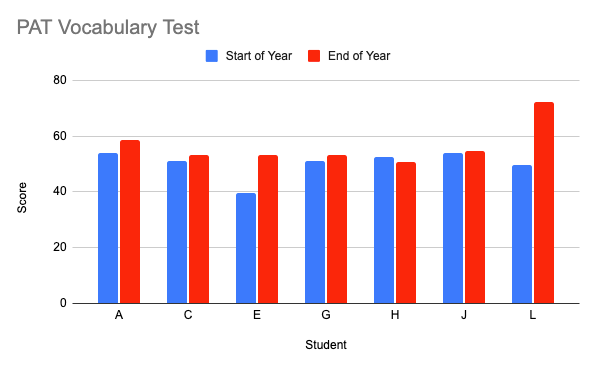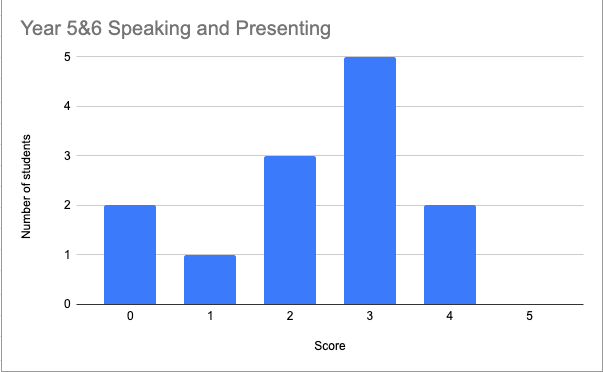The challenge: There is a disparity between the level of oral language and vocabulary which the year 5-6 extension children use and the level of language and vocabulary they can read and recognise in written texts.
My target group of children are all very good readers however find it challenging to demonstrate the same level of understanding and use of vocabulary through speaking and presenting.
Purpose: Create a profile of my teaching to support design of a useful intervention.
What do I currently do, relevant to my inquiry?
Currently, I teach the year 5-6 extension class 2x a week which equates to approximately 3 hours a week. The children work on group projects over a term where they have to demonstrate team work, collaboration, and practice speaking and presenting in their group and then finally in front of their peers. Also during this time, I read a novel aloud to the children. Once a week, the children also complete questions on a reading text with a focus around vocabulary development.
At the end of the term, the children are assessed off a rubric for their collaborative projects.
Manaiakalani Observation
This term, I had Fiona Grant from Manaiakalani observe how I incorporate reading into my Extension class programme. She used the Manaiakalani Observation Checklist during the observation. The following description comes from this observation.
It was observed that the purpose of reading in the extension classroom was for reading to learn. This is in line with the fact that these children are all at a level of their reading where they are accessing texts in order to find information. In the planning for this session, it was observed that I had planned for teaching comprehension strategies, critical thinking (analysing), critical thinking (synthesising), critical thinking (making connections to the wider world), and student reflection. In my planning, there was also evidence of literal questions and open ended questions. In the session, the children had opportunities to see short texts, non fiction texts, a text for a general audience (e.g. newspaper), printed text, digital text, pictorial text (e.g. image), video text, teacher selected text and a text set. Through the session, it was observed that I had ambitious learning intentions. This is what I want to be including for the extension learners as well as to build their oral language skills. I also planned for activities to support consolidation of learning and mileage.
It was observed that I had a purpose to the learning and provided the children with a provocation. However, engagement was lacking. This is a really important part of the observation as I need to think about how I can create better engagement for the children. I wonder whether providing more choice for the children will support better engagement.
In the direct instruction, I included teaching of new vocabulary as well as giving a new context for known vocabulary. This is something I need to ensure I keep doing to develop the children's knowledge and confidence.
In learner follow up activities, it was observed that I provide reflection on strategy use. This will be important to explicitly teach and do so children know the strategies which will support their development of speaking and oral language. Follow up activities were collaborative which supports development of oral language.
I could be doing a better job of planning for critical thinking (evaluating) and critical literacy as well as giving the children opportunities to take part in extended discussions and providing them with conversation scaffolds. It was observed that I did include opportunities for evaluation in the lesson, however I need to be explicitly planning for this. I could be considering providing children with longer texts, audio texts and learner selected texts in relation to the topic.
Even though conversation scaffolds were not evident in my planning, they were evident in the direct instruction. I therefore need to ensure I am explicitly providing the children with these conversation scaffolds.
What are my strengths?
1. Giving the children choice. I like to give the children choice in terms of how they present their final product from their project.
2. Encouraging deeper thinking using causal links. I ensure that I do not accept yes/no answers from the children. I set up an expectation that the children have to answer a yes/no question with an explanation. That is, 'Yes/No because..." or "I thinking ________ because." for example. Using causal links has been a big focus of my previous inquiries so it is engrained in my teaching practice.
3. Collaboration. Creating collaborative opportunities.
4. Teaching new vocabulary and sharing this vocabulary in new contexts. I can do a better job of keeping a record of this new vocabulary which we learn.
What are some areas I could develop?
For this question, I want to reflect on my latest lesson that I planned for this class. This term, we are looking into the topic of meteorology. For this topic, I first had the children research a number of weather instruments that are used to measure weather conditions. Here are the slides which the children worked from:
This first lesson was extremely scaffolded as I wanted to ensure the children all had a broad understanding of weather and how it is measured before the children moved off into their group projects. Interestingly, many of the children really struggled with what I thought would be quite a simple task. As a result, I had to stop and think what I could be doing better to support the children with this task.
1. I could be doing a better job of giving these children more real-life experiences before getting them to research. Perhaps what the children needed in this research activity was to see the weather instrument in action.
2. I could be doing a better job of explicitly teaching alongside project-based learning. I need to improve in my ability to ensure that each child is presenting on NEW learnings, not just things they already know. In last term's project, the children really enjoyed creating their DLO which they would share with the class, whether it be a movie, a poster or a coded animation. One common observation though was the number of groups who tended to present on information they already knew, rather than included NEW information. Perhaps this is partially a confidence issue but I also need to look into what I can be doing as the teacher to support them to share their new learning. I need to be asking myself the following question:
"Could this child/these children presented this at the start of the term or have they only presented this as a result of their new learning?"
I could be getting the children to ask themselves this question:
"What is some new learn from this experience that I didn't know before?"
Something that came up from the observation which I would like to work on is creating more engagement learning experiences. I wonder whether part of this is that we have had limited time together as a class this term so I have not provided as much choice as I would have previously. Even so, it is an element of my teaching which I should really focus on.
I also need to think about how I can provide opportunities for the children to be part of extended discussions. Often I find that the children have difficulty focussing long enough to participate in extended discussions. As a result, part of my inquiry should be on providing children with conversation scaffolds which could support their engagement in an extended sense.
What do the students say (student voice)?
In the student voice survey, this is what the children told me I could help them with in terms of speaking and presenting:
1/17: Management of emotions/ feeling
1/17: Using better vocabulary
1/17: Handwriting
1/17: Memory
1/17: Knowing how to explain my thinking
1/17: Spelling
2/17: Other people showing respect while I'm speaking
2/17: Get better at Maths, Writing and Reading
3/17: Give me books to read
5/17: Give me opportunities to talk so I don't feel nervous and can practice speaking up and expressing what I feel when I talk / Confidence
Interestingly, some of these are points really resonate with the data I collected from observation and assessment. For example, the children know they need help with using better vocabulary when they speak and present. They also know they need help with knowing how to explain their thinking and being given opportunities to speak to develop their confidence. Some of their other responses though show a possible lack in knowing what they need to get better at speaking and presenting. For example, thinking that getting help with handwriting and spelling will help their speaking and presenting.
Current analysis of The 'Big Six'
1. Ambitious outcomes for all. The learning experiences that I develop for these children are ambitious and provide opportunity for growth and development for all. The learning experiences have both a low floor and a high ceiling so all can access learning from them at all levels.
2. Eyes on text. This is something I can continue to work on developing. When I have these children for a short time, I need to find these best way to do this. I need to continue gifting texts to the children at their level which are related to the topic focus. This would still be possible through group projects where the children read a text and pull new learning from it to support their projects.
3. Language and vocabulary development. I am providing opportunities for the children to do this as a result of it being the focus of my inquiry. I am doing this through weekly texts, reading of novels, opportunities to work as a team and opportunities to speak and present.
4. High Level Discussions. This is something I can continue to work on developing. This needs to be working hand-in-hand with the third point (Language and vocabulary development) as a result of doing the second point (Eyes on text). I need to be giving the children strategies and prompts to be able to have these high level, effective and productive discussions.
5. Transforming and transference of knowledge through creation. As a said above, I need to be teaching the children to transform and transfer NEW knowledge through creation, not just the knowledge that they previously held.
6. Making thinking visible. This is happening as an end product however I could be encouraging the children to complete video diary entries to share their learning during the term as well.
Causal Chain
(Click on image to enlarge).






























